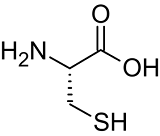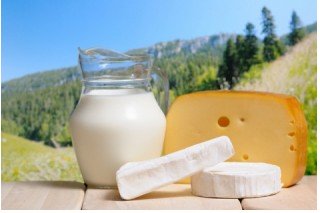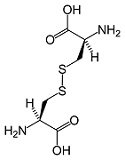|
Cysteine
The antioxidant activity of
Glutathione (GSH)
is attributed specifically to the presence and availability of this amino acid.
Oral glutathione cannot be effectively used to build glutathione in cells (details are on our page
Oral Glutathione).
The body requires three amino acids - glutamate, glycine and cysteine – in order to manufacture glutathione on its own inside the cell. WHY IS CYSTEINE IMPORTANT? The “SH” in the glutathione abbreviation “GSH” stands for the critically active sulfur sulfhydryl group. Cysteine is a sulfur-containing amino acid that contributes to the sulfhydryl group in the glutathione molecule. This makes cysteine the most crucial of the three building blocks for glutathione. This means that the level of cysteine in your system is the limiting factor in how fast you can produce glutathione and how much of it you can make. When cells have cysteine they are able to manufacture glutathione. Low levels of this all-important amino acid may reduce your ability to prevent free radical damage and may result in impaired function of the immune system. Unfortunately, cysteine is deficient in many diets. In addition to low amounts of cysteine being present in our diets, only the cysteine of a specific form can actually enter the cell. In order to determine the best source of cysteine for building intracellular glutathione, let’s take a closer look at the sources of this crucial amino acid and how the body uses them. CYSTEINE PRODUCED BY THE BODY
Your body can and does produce some cysteine on its own from another amino acid – methionine, which is also a sulfur-containing amino acid. Methionine is an essential amino acid, meaning it is not produced by the body but comes from diet only. Food sources of methionine are: all meats and poultry, fish, eggs, dairy, quinoa, buckwheat, sesame seeds, Brazil nuts, and to a lesser degree dry spirulina. While methionine can be found in other foods as well, such as beans and legumes, the amount of methionine is too low to be of any benefit for significant cysteine production and ultimately glutathione production for your immune health. The process of transformation of methionine into cysteine is a multi-step process, very complex and requires the presence of certain enzymes and B-vitamins. Any small deficiency in this long complicated chain of events, from consumption to enough glutathione to boost the immune system, and you are left with a compromised immune system that lacks sufficient glutathione for multiple “T” cell cloning to occur. The process of transforming methionine into cysteine can be interrupted by a number of things. Liver diseases and impaired metabolism are the most disruptive to this process, and this process is completely non-existent in newborn babies. Fortunately for babies, mothers’ milk is loaded with sulfur-containing bonded cysteine (more details in the next paragraph). Some of the cysteine that does get produced from methionine can be used for manufacturing glutathione inside the cells. Unfortunately, methionine also converts into homocysteine in the body. Homocysteine has been identified as a high risk factor for hardening of arteries (atherosclerosis). For this reason methionine cannot be considered the main source of cysteine for building glutathione, and supplemental methionine (L-methionine) should be avoided.
CYSTEINE FROM FOOD SOURCES
Small amounts of cysteine can be found in other plant sources: broccoli, Brussels sprouts, red and yellow bell peppers, onions, garlic. In food cysteine is bound into protein molecules by amide (peptide) bonds. High temperatures during cooking break down these bonds and destroy bioactivity of cysteine. If plant sources of cysteine are consumed raw, then harsh stomach acids break down these bonds. Free cysteine either gets snatched up by stomach and intestinal bacteria (they need it, too!), or if free cysteine survives the trip into the bloodstream, it cannot enter the cells. For cysteine to bypass the stomach acids, one will have to eat some 50 lbs. of raw veggies a day, or – 4-5 lbs. of raw meat, which is out of the question. Study “Immunoenhancing property of dietary whey protein in mice: role of glutathione” led by Dr. Bounous and Dr. Batist and published in Clinical and Investigavive Medicine demonstrated that mice fed dietary (free) cysteine showed no positive immunological response.
And there is one food source out there with very interesting qualities where cysteine molecule remains intact during digestion. Raw cow’s milk (or rather, milk whey) contains three highly bioactive proteins: lactoferrin, serum albumin and alpha lactalbumin. These proteins contain exceptional amounts of cysteine. And most importantly, in the form that can enter cells: each cysteine molecule is bonded with another cysteine molecule by a disulfide bond or bridge:
These disulfide bonds are very fragile and easily denatured by heat and mechanical stress. Pasteurization of milk multiple times at high temperatures before it reaches your table, as well as mechanical stress during centrifuging, destroy these bonds. It makes cysteine from supermarket milk (and all mainstream dairy for that matter) absolutely useless for building glutathione. Humans outsmarted themselves by ruining the only viable food source of cysteine. For generations unprocessed milk, cheeses and yogurts used to be our ancestors’ sources of this critical glutathione precursor.
Retail sale of raw milk is currently legal only in 10 US states, with another 4 states allowing it for pet consumption only. To find a raw dairy farm near your residence visit this raw milk farm locator (the page will open in a new window). If you live in Pennsylvania, New Jersey, New York City tri-state area, eastern Ohio, northern Maryland, north-eastern West Virginia, check out Raw milk will supply your body with cysteine. However, 1-2 glasses a day is not enough to raise glutathione levels noticeably. To do that one will have to drink a minimum of 1-2 gallons a day, or more in case of a serious illness. Still, it is a great way to provide your body with additional cysteine in this natural form that can easily enter cells and be used as a building block for glutathione. None other food is able to do that! Human breast milk contains large amounts of lactoferrin, serum albumin and alpha lactalbumin, as well as other immunoglobulins - so it is loaded with bonded cysteine. This is one of the reasons why mother's milk is such a strong immune system builder for a baby, and why it is very important to breastfeed your child. No baby formula will supply bonded cysteine for building glutathione. CYSTEINE AS A SUPPLEMENT L-CYSTEINE
Cysteine is available as a supplement from health food stores and pharmacies. It is usually labeled “L-cysteine”, and the most common dosage is 500 mg in pill, tablet or capsule form. Science has proven that supplemental cysteine may in fact raise intracellular glutathione to a small degree, especially in cases of severe glutathione depletion. However, cysteine as a dietary supplement can promote hypercysteinemia and can be potentially toxic. Its absorption into bloodstream is limited because it is easily oxidized in the digestive tract. Further oxidation in the bloodstream leads to formation of potentially toxic byproducts, some of which may contain a highly reactive oxidant – hydroxyl radical. Cysteine toxicity leads to a number of disorders in the body, from heart disease to renal (kidney) disease. Due to the potential for cysteine toxicity, excessive homocysteine levels and potential hypercysteinemia, it is not recommended to take L-cysteine supplements without strict supervision from your physician, especially if there are underlying health conditions. In addition to being a dietary supplement, L-cysteine is also used in baking as a dough conditioner – you might find it on the ingredient lists of some commercial breads and other baked goods. It is also used as a flavor enhancer in both human and pet food (it contributes to meat flavor). A derivative of L-cysteine called N-acethyl-cysteine or NAC is widely used as a drug – we will discuss NAC in the next paragraph. L-cysteine can be of synthetic and natural origin. Synthetic L-cysteine is made either using industrial chemicals that undergo biochemical transformation with the help of enzymes, or from chemicals using a microbial fermentation process. Because synthetic L-cysteine is very expensive to manufacture, natural L-cysteine is more widely used. How is it made? The process is actually quite gross. Since cysteine is naturally abundant as a structural component of keratin (a protein that hair is made of), L-cysteine is made from human hair, duck and chick feathers and pigs’ bristles. Most of L-cysteine supply comes from Asia, mostly China, where hair is collected from the floors of barber and hairdresser shops. Then hair or feathers are either boiled in concentrated hydrochloric acid and other chemicals, or in a different process, they sit in a broth of mutated harmless E. coli bacteria, sugars and minerals. The end product of hair breakdown is L-cysteine. In recent years, because of the growing concern from vegans, vegetarians and various religious groups, feathers have been used more often than human hair. However, almost free cost of hair will not allow it to completely disappear from the market. According to the FDA guidelines, when L-cysteine is used as a flavor it does not have to be listed on food labels. When it has to be labeled, the source is not required to be mentioned. To find out whether synthetic or natural L-cysteine was used in your food you should call the manufacturer. Info sources (each will open in a new browser window): CYSTEINE AS A DRUG NAC
NAC stands for N-acetyl-cysteine (also known as n-acetyl-l-cysteine). It is a variant of L-cysteine with an acetyl molecule attached to it. This variation in molecular structure enables cysteine to survive the digestive tract and get into cells, thus increasing cysteine’s bioavailability, in other words – usefulness for building glutathione. For several decades NAC has been used as an effective drug for breaking up mucus in lungs of patients with asthma, emphysema, chronic bronchitis and cystic fibrosis. This drug is an active component in inhalers. Another application of NAC, usually intravenously, is at hospital emergency rooms to treat cases of acetaminophen (Tylenol) overdose. It is used to rapidly spike glutathione levels in patients with overdoses to save their lives. Also, NAC has been used in research on HIV patients when it became known in the early 1990s that such patients are severely glutathione deficient. Since then NAC has been used with positive results in many animal and human trials in a wide range of diseases characterized by oxidative stress and low glutathione levels. Non-prescription NAC is sold as a dietary supplement in pill, tablet or powder form. It can also be an ingredient in various supplements advertised as immune system boosters. Either in clinical use or as a supplement, NAC therapy has two common problems: it is a pharmaceutical drug which has certain toxicity, and glutathione levels induced by NAC reach a rapid peak and decline within hours. These rapids spikes in GSH levels are usually followed by a drop, often below normal levels. To maintain elevated glutathione levels NAC must be taken or injected several times a day which is very hard on human body. According to the information from WebMD, possible side effects of oral NAC are:
In his bestseller “Glutathione. Your Key To Health” Dr. Jimmy Gutman states: “Although rare, death has been reported in association with NAC”. According to drugs.com, there are 6 drugs known to interact with NAC. See the list here (will open in a new window). Some people have a hard time tolerating the taste and smell of NAC – it resembles that of rotten eggs due to sulfur content. NAC as a cysteine delivery system should not be used without professional medical advice. In addition, a recent randomized and placebo-controlled study (2013) linked NAC supplements with hindered muscle performance and increased recovery time for several days after athletic exercise (Thiol-based antioxidant supplementation alters human skeletal muscle signaling and attenuates its inflammatory response and recovery after intense eccentric exercise. Michailidis Y. et al. Am. J Clin Nutr. 2013 Jul;98(1):233-45. doi: 10.3945/ajcn.112.049163. Epub 2013 May 29.). CYSTEINE IN UNDENATURED WHEY PROTEIN Raw cow’s milk contains 5-10% protein, out of which 80% is casein and 20% whey. And as I mentioned above in paragraph Cysteine From Food Sources, this whey contains potent GSH precursors - lactoferrin, serum albumin and alpha lactalbumin, rich in bonded cysteine that is able to survive digestion, enter the bloodstream and cross the cell walls. As an interesting comparison, proteins in human breast milk contain only 40% casein and 60% whey - this makes mother’s milk an exceptional source of bonded cysteine. For whey protein to be effective in raising glutathione it must be kept undenatured – unheated and unaltered – at all times during the manufacturing process. The unique quality of undenatured whey proteins as a source of highly bioactive cysteine was discovered in the late 1970s by Dr. Gustavo Bounous, a renowned researcher in the field of nutrition at McGill University in Montreal, Canada. One day a cheese manufacturer from Switzerland sent whey protein powder, a byproduct of cheese production, to Dr. Bounous requesting him to investigate its possible application. Preliminary study revealed that mice fed this whey protein exhibited a much better immune response than mice fed a regular diet. Subsequent studies confirmed these exiting results. As a result of extensive research done by Dr. Bounous in the 1980s, undenatured whey protein isolate was developed which has been successfully used in studies on humans including research into HIV/AIDS, hepatitis, Lyme disease, bacterial infections, cancer therapy, lung diseases, chronic fatigue syndrome and other conditions characterized by low glutathione levels and high oxidative stress. Undenatured whey protein concentrates or isolates are an excellent source of bioavailable cysteine and other glutathione precursors to support natural glutathione production.
|
 Cysteine is present in all high-protein foods: all meats and poultry, dairy and eggs, quinoa, buckwheat.
Cysteine is present in all high-protein foods: all meats and poultry, dairy and eggs, quinoa, buckwheat. 
